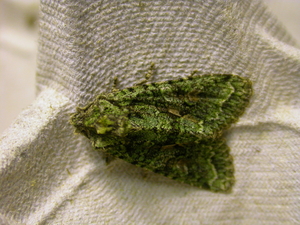Last night I tagged along to the last moth survey activity at Goat Meadow, a clearing by the woods on the edge of Gatwick. I’m still a complete novice when it comes to moths, so it was great to have Jake Everitt there to identify things, and to point out the key features. Mercifully, there were a few I recognised from the last time (even if I couldn’t quite remember the names), such as Rivula sericealis (Straw Dot), Atethmia centrago (Centre-barred Sallow), and Campaea margaritata (Light Emerald).
However, there were also a few common moths that, though I’d seen before, had no recollection of them at all: Xestia xanthographa (Square-spot Rustic), Chloroclysta truncata (Common marbled carpet) and Noctua pronuba (Large Yellow Underwing). Another that I had also seen at the last moth survey was the micro moth Carcina quercana, whose foodplants include oak (hence the name) and beech.
We also found the micro Anania crocealis (= Ebulea crocealis), the larvae of would have fed on the fleabane that was all over the woodland fringes, though the picture is a bit rubbish.
Rubbish pictures were the order of the day, as it got cold and damp, and I didn’t feel much like fiddling around with the camera, so this picture of the Noctuid moth Gortyna flavago (Frosted Orange) could have been a bit better too; it certainly doesn’t adequately show how brightly coloured it was.
However, the last picture from the trap was the best, and what a gorgeous animal Dryobotodes eremita (Brindled Green) is:
Other moths in the trap that were new for me were Omphaloscelis lunosa (Lunar Underwing) and Cymatophorima diluta (Oak Lutestring), of which there were several, and a single Thera firmata (Pine Carpet). So, not a huge haul, but a good-enough selection of late season moths for me to try and remember.
To make up for the paucity of moths, Rachel Bicker pointed out a few of the common spiders (another group I know almost nothing about), such as Araneus diadematus, and Araneus quadratus, as well as Metellina segmentata, then found Nuctenea umbratica (Walnut orb-weaver) on the gate on the way back.
So, sustained by coffee and (later) a fire, it was a very enjoyable evening.























